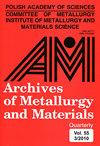通过机械合金化和氢还原法合成多晶双掺杂 Snse
IF 0.7
4区 材料科学
Q4 METALLURGY & METALLURGICAL ENGINEERING
引用次数: 0
摘要
本研究通过高能球磨和氢还原 Bi2O3 的方法制备了掺铋的 SnSe,并对其热电性能进行了分析。纯铋试样作为对照组,并对其性能进行了比较。添加了 Bi2O3 的试样在氢气环境中烧结时,熔点较高的 Bi2O3 被还原成熔点相对较低的 Bi。此时,由于液相的出现,(400) 面的取向增加,密度提高。因此,在 300 K - 773 K 的温度范围内,由于掺入了 Bi,SnSe 变为 n 型的情况得到了证实。此外,当使用 Bi2O3 代替纯铋时,与优点系数成反比的热导率降低,而电导率增加,从而改善了优点系数。本文章由计算机程序翻译,如有差异,请以英文原文为准。
Synthesis of Polycrystalline Bi-Doped Snse by Mechanical Alloying and Hydrogen Reduction
In this study, Bi-doped SnSe was fabricated through the high energy ball milling and the hydrogen reduction of Bi2O3, and its thermoelectric properties were analyzed. The specimen with pure-Bi was fabricated as a control group and properties were compared. In the case of specimens with added Bi2O3, when sintering was performed in a hydrogen atmosphere, Bi2O3 with a high melting point was reduced to Bi with a relatively low melting point. At this time, because of the appearance of the liquid phase, the orientation of the (400) plane increased, and the density was improved. As a result, the change of SnSe to n-type was confirmed in the temperature range of 300 K - 773 K due to Bi doping. Additionally, when Bi2O3 was used instead of pure-Bi, the thermal conductivity, which is inversely proportional to the figure of merit, decreased, and the electrical conductivity increased, resulting in an improvement in the figure of merit.
求助全文
通过发布文献求助,成功后即可免费获取论文全文。
去求助
来源期刊

Archives of Metallurgy and Materials
工程技术-冶金工程
CiteScore
1.20
自引率
0.00%
发文量
0
审稿时长
4.5 months
期刊介绍:
The Archives of Metallurgy and Materials is covered in the following Institute for Scientific Information products: SciSearch (the Science Citation Index - Expanded), Research Alert, Materials Science Citation Index, and Current Contents / Engineering, Computing and Technology.
Articles published in the Archives of Metallurgy and Materials are also indexed or abstracted by Cambridge Scientific Abstracts.
 求助内容:
求助内容: 应助结果提醒方式:
应助结果提醒方式:


